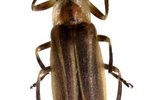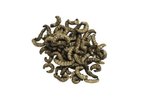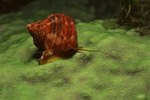
As a supplemental food or the main diet, bloodworms -- the larvae of chironomid midges -- are appreciated by all sorts of aquatic pets, including most omnivorous or carnivorous fish and many amphibians. Raising your own might not save a great deal of money, unless you have extremely large, hungry fish, and isn’t as straightforward as raising, for example, brine shrimp, but dedicated hobbyists might enjoy the challenge.
What You Need
Bloodworms have fairy simple needs, and all you really need to get started are some leak-proof glass or plastic containers, such as small fish tanks or large plastic storage boxes, plus garden soil and a bit of animal manure. Pieces of muslin secured with large elastic bands keep mosquitoes away, although this might not be a problem. The animals that like eating bloodworms usually like mosquito larvae, too.
Setting Up
Add a thin layer of garden soil to each box and a small amount of animal manure. Farm animals produce suitable waste but, obviously, don’t use cat or dog feces since these are a health hazard. Top up with rainwater. Stir and slosh it all about with a stick and position the container in a dark place. All you need now are chironomid eggs, which you’ll probably have to collect yourself. Look for globular jelly-like masses stuck to plants in ponds or on the surface. Chironomid eggs look like a tiny version of frogspawn.
Maintenance
Feed the bloodworms by adding a little additional manure about once a week. You probably won’t need to clean the tank, because bloodworms reach maturity in less than two weeks. If you collected the eggs from the wild, it is ecologically responsible to let some of the larvae, about 1 to 5 percent, pupate and to release the adults. This also ensures a plentiful supply of eggs for you to collect in the future.
Catching
As the bloodworms grow, net batches to feed your fish as required. Net them at night, when they are most active. It is advisable to release the bloodworms into a bucket of dechlorinated water and re-catch them, to rinse them. Repeat a couple of times. The ideal conditions for raising bloodworms are hardly sterile, so rinsing helps avoid introducing potentially dangerous microorganisms into the fish tank.
Breeding Bloodworms
Because bloodworms are the larval stage of chironomid midges, breeding them is a good bit trickier than raising them. You’d need a pretty large set-up, something like a greenhouse, to allow the adults to swarm and mate. A simpler option would be for you to set up a set of ponds or pond-substitutes, using any large, wide plastic containers, in your garden to encourage wild ones to multiply on your property. Coupled with organic gardening, this ensures a steady supply of treats for your pets, although be aware that you’ll probably also encourage mosquitoes. These midges don’t bite, but mosquitoes do, so be careful you don’t cause a problem for yourself or your neighbors.
References
Photo Credits
-
Jupiterimages/Photos.com/Getty Images
Writer Bio
Judith Willson has been writing since 2009, specializing in environmental and scientific topics. She has written content for school websites and worked for a Glasgow newspaper. Willson has a Master of Arts in English from the University of Aberdeen, Scotland.




